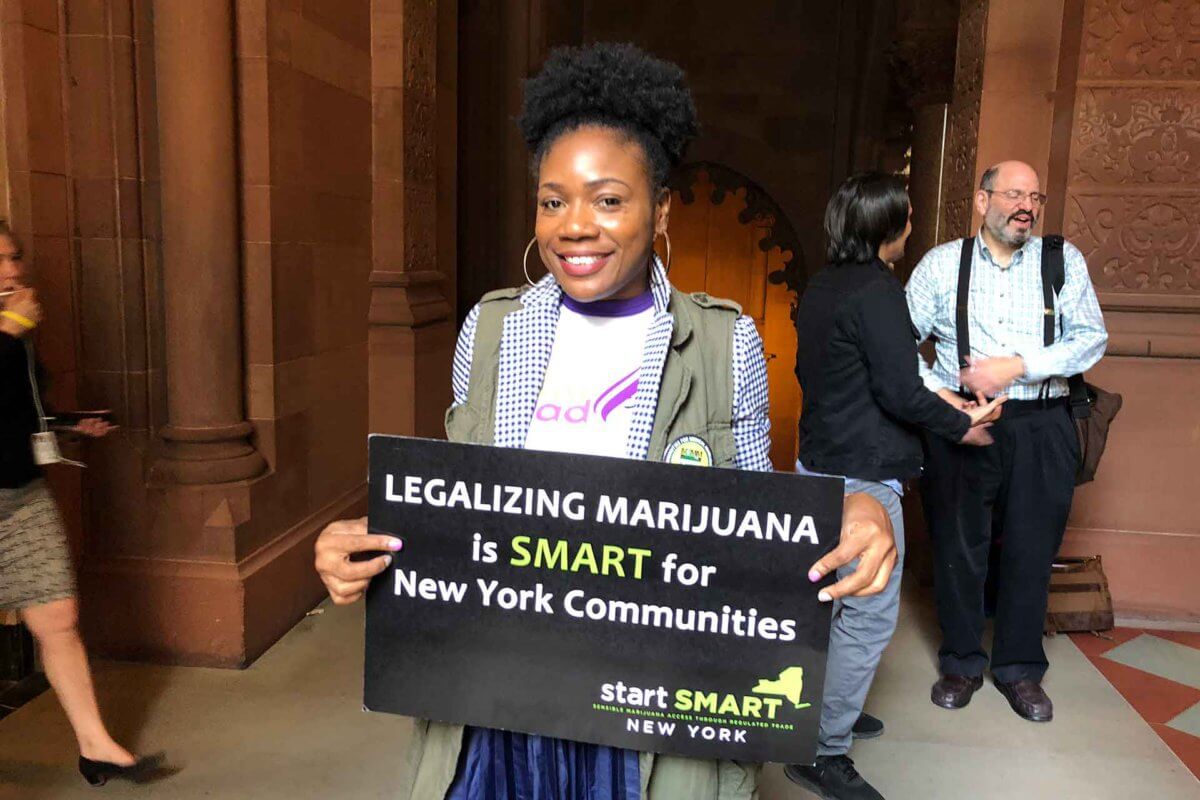 by Elise Serbaroli of Strimo, interview conducted May 2021
by Elise Serbaroli of Strimo, interview conducted May 2021
Elise Serbaroli is a member of the NCIA’s State Regulations Committee, “Informing Local Governments” subcommittee, which aims to bridge knowledge gaps between operators and regulators in the cannabis industry. This is done through interviews with current cannabis regulators in various U.S. states, sharing best practices and lessons learned.
Dasheeda Dawson is a cannabis regulator in Oregon and co-founder of the Cannabis Regulators of Color Coalition (CRCC). As cannabis czar for the City of Portland, she is the highest government official overseeing and advising on cannabis regulation for the municipality. Ms. Dawson brings an incredible breadth of experience to the cannabis space. A self-proclaimed “corporate to cannabis crossover”, she is perfectly positioned to navigate and lead the complexity that is the legal cannabis industry. Before becoming a best-selling author (“How to Succeed in the Cannabis Industry”), she held leadership roles at Victoria’s Secret and Target. Her career is built off of a solid educational foundation, including a Princeton degree (Molecular Biology & African-American studies) and an MBA from Rutgers.
Can you tell us how you got into the cannabis industry?
For the five years prior to formally getting into the industry, I was what you would call a “closeted cannabis consumer/patient.” I have early signs of MS and my mom was actually the one that insisted I give it a try. At the time, I was working at Target in Minnesota. Cannabis was my saving grace for maintaining productivity and overall capabilities. My mom passed away unexpectedly in 2016 and it jolted me out of the standard corporate trajectory I had been on. I ended up moving to Arizona and became a medical cannabis patient there, jumping into the advocacy side of the industry. Arizona legalized adult-use this past November!
From Target to Cannabis Czar! Did you always plan on becoming a regulator?

Certainly not! Straight out of the gate, I got a lot of work as a consultant in the industry, using everything that I had done in my corporate career, including business strategy and supply chain management. I had owned everything for my categories at Target and when you’re the business owner, you lead and oversee the entire cross-functional team. I applied that to the cannabis space as quickly as I could, working for a lot of clients and gaining an entrepreneurial education from working with large cannabis enterprise clients, small operators, multi-state operators, Native American tribes, even government. I gained the truest sense of how NOT to do it. In a corporate role, you usually write a report about what you have learned, insights, etc., and then you move forward. My workbook, now in its 3rd edition, was really built off of those lessons learned.
When COVID hit, my book tour was abruptly stopped overnight! At the same time, I was selected to become the Cannabis Program Supervisor for the City of Portland. I was only the third Black woman at the time to be selected to oversee a cannabis regulatory office. I believe that now there are more, but women and people of color are scarce in these positions. Most of the regulators are white men, many of whom come from another regulatory agency, like liquor or law enforcement. In order to assure that cannabis regulation is equity-centered, you need people at the table that will center equity. This last year has been amazing. I have a lot of runway and support to be exactly who I am, which is the Weed Head (TM). I refuse to be anything else and I’m in a bureau that allows me to do that.
What exactly is a cannabis czar?
On the state level, the Oregon Liquor Control Commission is currently passing legislation to become the Oregon Liquor AND CANNABIS Commission (OLCC), primarily because cannabis is providing substantial revenue for the state. Most of those people are liquor regulators, and they have organized a sub-group, focused only on cannabis. It started off with four people and now there are 50!
As Portland’s cannabis czar, I am a municipality leader, similar to Cat Packer in Los Angeles, and operate independently of the OLCC. Portland represents approximately 40% of the total cannabis revenue for the state and I oversee the entire cannabis program, including regulatory, licensing, compliance, community impact, and equity initiatives for Portland’s medical and adult-use programs.
In the city of Portland, cannabis regulation and oversight was placed in the Office of Community and Civic Life, as opposed to in the Office of Finance and Revenue or the Office of Business Development Services, which is where they license other businesses. This placement is partly due to the idea at the time that the cannabis industry was going to be disruptive to the community. Many individuals were worried about safety for communities. Our office has been trying to decrease the stigma and canna-phobia around the plant, offering education and equity initiatives. We were the first city to have community reinvestment grants tied to our cannabis tax revenue. These grants are administered through the SEED (Social Equity and Educational Development) Initiatives and grant fund.
You recently launched the Cannabis Regulators of Color Coalition (CRCC). Is that initiative part of CannRa?
CRCC and CannRa are two independent organizations, which happened to both launch at the same time. This caused some confusion in the industry. They are not mutually exclusive memberships! In fact, two of our founding members are also founding members of CannRa. The regulators roundtable was the predecessor of CannRa and that association aggregates insights and learnings state by state. The Oregon Liquor Control Commission (state-level) is a member of CannRa.
CRCC centers equity and support of legalization, while also aggregating insights and learnings state by state. If you are a regulator of color, at the state or local level, it makes sense to join the Cannabis Regulators of Color Coalition. We know that legalization is a requirement to start to undo the harm done through the war on drugs.
Centering equity involves re-thinking how we regulate this industry. One challenge is getting people to realize that this is a regulatory agency, like any other government regulatory agency. The Department of Motor Vehicles (DMV), a regulatory agency, gives out licenses and adjusts to assure that no group is precluded from access (adjusting for wheelchairs, visual and hearing impairments, etc.). Yet, in cannabis, we are regulating the industry without dealing with the inequities in the industry. Some of these inequities are directly linked to the historical prohibition of cannabis and the war on drugs, which we define as the racially-biased enforcement of cannabis prohibition.
Supporting equity also includes gender inequities, economic inequities, and disability inequities, to mention a few, that will positively impact everyone in the industry, including and especially patients themselves. Exclusionary practices would not be tolerated if it was an agency like the DMV. With cannabis, we are over-regulating the industry and excluding many people from participating, which is to the detriment of the market and the community. CRCC is focused on equity-centered regulation for the cannabis industry.
What is one thing that you would like to see in the legislation for cannabis businesses at the federal level?
Well, there’s a misconception about the size of companies in this industry. As an industry, we have to be careful about supporting legislation that only benefits large corporations. More than 75% of cannabis businesses have annual revenue of $2 million or less. Compared to small businesses in other industries, for example, in agriculture ($6 million or less) and retail ($14 million or less), cannabis businesses are very small, so everyone needs to push for legislation to benefit these small businesses in whatever regulatory framework is set up on a federal level. This is one step in leading the industry towards a more equitable path.
One aspect of inequity is how cannabis businesses of different sizes are treated. On average, very small cannabis companies have an after-tax rate of 70%, so when you’re going to the table for the regulatory framework, push back on the tax structure, push back on mechanisms that are inherently disadvantageous to small businesses. Surprisingly or not, most Black, Indigenous, or Latinx businesses are also small businesses, so you are positively impacting racial equity.
If you, as a cannabis business, think you’re a big fish, trust me, Big Tobacco, Big Alcohol, Big Pharma, Big CPG (“consumer packaged goods”) – Target has $70 billion in annual revenue – are coming, so a big fish in this cannabis pond is setting itself up to be eaten by much bigger fish and bigger sharks. If we leave back doors open for the larger cannabis businesses, we’re leaving that same back door open for a Walmart or an Amazon. Large corporations are already investigating and supporting cannabis. They plan years in advance for large takeovers and once it starts, it’s a stampede of well-financed, organized strategic efforts.
At a state level, the industry and those who want to support the industry, need to be careful to not overtax the small businesses and to vote to provide a framework of support mechanisms for small cannabis businesses.
What are some examples of frameworks that support or negatively impact small cannabis businesses?
Some of the early legalization efforts required vertical integration. Because of the way the state and local jurisdictions are regulating and taxing, forcing vertical integration is not a small-business-friendly approach to licensing. This was the case in some earlier states, but we’re also seeing newer states like Georgia taking this approach.
By breaking up the licensing into different parts of the supply chain (like California), you open up possibilities for smaller businesses to operate. If the state is giving out micro-business licenses, there should also be a track to grow into a larger size so that there is no ceiling on those businesses’ growth prospects. For example, in New Jersey, advocates fought to amend provisions that failed to create a way to sell out of a micro-license for a growth event.
Everybody has a different opinion depending on which economist you talk to about how you tax up and down the supply chain. I’d like to see states have tiered tax by production weight. Once you start doing it by the percentage of THC, you’re negatively impacting businesses and patients. It’s meant to be a deterrent and is an example of the government intending to overregulate in an area that it doesn’t fully understand. But usually, those penalties wind up impacting the smaller craft businesses. Too many people are assuming that consumption in the adult-use market is just for recreational purposes, but there are plenty of small niche operators aimed at a specific medical community and they are producing small batches, for example, with high THC, but their clientele may be negatively impacted, simply as a function of the way the tax law was written.
Thanks, Dasheeda, for taking the time to speak with us! If readers want to get involved in changing legislation and connecting with regulators, where should they start?
It’s certainly a long and hard process when dealing with big issues and change. For operators, NCIA is a good place to start. There is also the M4MM and the MCBA. Folks should really try to connect with the local- and state-relevant organizations. Building and operating in coalitions can be very powerful. On a national level, be sure that any group you are part of is actually going to D.C. and is having conversations with the legislators, because at the end of the day, whether it’s cannabis or any other business, you need to be involved with influencing the policies that impact your industry. Everything starts with the law and civic engagement.
 Elise Serbaroli leads Global Business Development at Strimo, where she provides cannabis businesses with software solutions around inventory management, cost accounting, QA, and compliance. She’s back in the USA after over a decade of experience in Spain, Germany, Switzerland and Ecuador.
Elise Serbaroli leads Global Business Development at Strimo, where she provides cannabis businesses with software solutions around inventory management, cost accounting, QA, and compliance. She’s back in the USA after over a decade of experience in Spain, Germany, Switzerland and Ecuador.
Understanding the importance of efficiency, scalability, and profitability, Elise created solutions to financial and legal processes for the R&D team at CPW, a joint venture of two of the world’s largest food companies, Nestlé & General Mills. As a systems coordinator, she gained a deep appreciation for food safety, GMPs and regulatory compliance. Her supply chain software experience builds off of her Business Development role at Tradeshift, the world’s largest network for digital B2B payments.


Follow NCIA
Newsletter
Facebook
Twitter
LinkedIn
Instagram
–